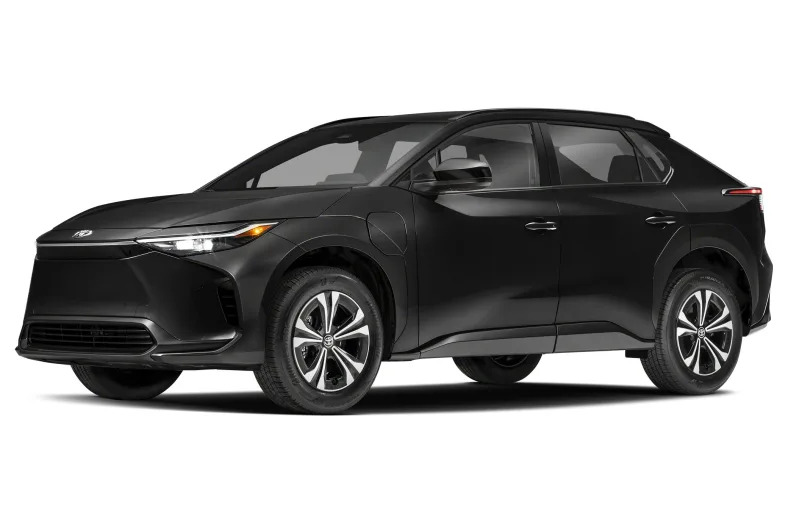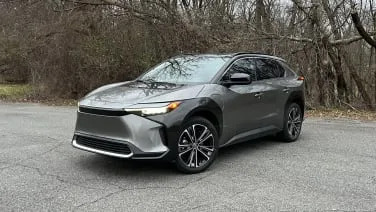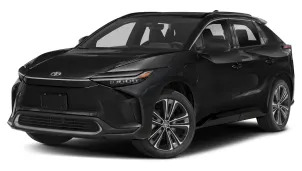2023 Toyota bZ4X
Pros: Good value with FWD; a relatively conventional small SUV; high ground clearance for an EV; useful interior storage Cons: Subpar range with AWD; slower to charge than some rivals; shine-in-your-eyes interior trim; hide-your-eyes styling This may come as a surprise, but the 2023 Toyota bZ4X is the first from-scratch electric Toyota. And no, the handful of RAV4 EVs produced to please California regulators do not count. Turns out the company that popularized the hybrid has been hesitant to join the all-electric revolution. The bZ4X speaks to that hesitancy: it’s an exceedingly safe effort with RAV4-like styling, as well as range, power and recharging specs that are hardly ambitious. Toyota even split the development with Subaru, which calls its AWD-only version the Solterra. For those wishing Toyota still sold a RAV4 EV today, the bZ4X should probably satisfy. For everyone else, there are ultimately more compelling EVs. At the same time, certain versions of the bZ4X present a strong value case. Specifically, the front-wheel-drive versions. You see, most other EVs like the Hyundai Ioniq 5, Kia EV6 and Volkswagen ID.4 come standard with a single motor powering the rear wheels. Their optional all-wheel-drive systems, which add a second motor for the front wheels, will be a must in wintery climates, but bring with them hefty performance and price increases. The AWD bZ4X instead swaps out its large front motor for a pair of smaller motors mounted one apiece to each axle – the performance upgrade is barely noticeable, but the price increase is roughly the same as what you’d find with gas-powered SUVs. Front-wheel drive is perfectly acceptable for winter, too, so you can easily bypass the AWD option altogether and enjoy more acceptable range (258 miles versus 228). Basically, it’ll be easier for more people to live with a base-model bZ4X XLE than the similarly priced Ioniq 5, EV6 and ID.4. It’s a more competitive car when cheaper, and is equipped well enough that you shouldn’t feel shortchanged. Just don’t expect something as fully realized as the exceptional Ioniq 5 and EV6, nor even the characterful but flawed ID.4. Safe isn’t a terrible way to go (Toyota sold 400,000 RAV4s last year), but we wish Toyota had been more ambitious, at least with the powertrain. Interior & Technology | Passenger & Cargo Space | Performance & Fuel Economy What it's like to drive | Pricing & Trim Levels | Crash Ratings & Safety Features What's new for 2023? The bZ4X is an all-new model. What are the bZ4X interior and in-car technology like? The bZ4X strikes a nice balance between functionality and achieving the more futuristic aesthetic typically demanded of an EV. Basically, it’s not too weird. There are physical toggles for temperature settings and the accompanying touch-sensitive climate buttons are illuminated and seemed responsive enough during our first drive (that said, we’d prefer a volume knob). The shifter is yet another new-fangled design that’s different for different’s sake, but was also easy enough to figure out. More basic …
Full Review
Pros: Good value with FWD; a relatively conventional small SUV; high ground clearance for an EV; useful interior storage Cons: Subpar range with AWD; slower to charge than some rivals; shine-in-your-eyes interior trim; hide-your-eyes styling This may come as a surprise, but the 2023 Toyota bZ4X is the first from-scratch electric Toyota. And no, the handful of RAV4 EVs produced to please California regulators do not count. Turns out the company that popularized the hybrid has been hesitant to join the all-electric revolution. The bZ4X speaks to that hesitancy: it’s an exceedingly safe effort with RAV4-like styling, as well as range, power and recharging specs that are hardly ambitious. Toyota even split the development with Subaru, which calls its AWD-only version the Solterra. For those wishing Toyota still sold a RAV4 EV today, the bZ4X should probably satisfy. For everyone else, there are ultimately more compelling EVs. At the same time, certain versions of the bZ4X present a strong value case. Specifically, the front-wheel-drive versions. You see, most other EVs like the Hyundai Ioniq 5, Kia EV6 and Volkswagen ID.4 come standard with a single motor powering the rear wheels. Their optional all-wheel-drive systems, which add a second motor for the front wheels, will be a must in wintery climates, but bring with them hefty performance and price increases. The AWD bZ4X instead swaps out its large front motor for a pair of smaller motors mounted one apiece to each axle – the performance upgrade is barely noticeable, but the price increase is roughly the same as what you’d find with gas-powered SUVs. Front-wheel drive is perfectly acceptable for winter, too, so you can easily bypass the AWD option altogether and enjoy more acceptable range (258 miles versus 228). Basically, it’ll be easier for more people to live with a base-model bZ4X XLE than the similarly priced Ioniq 5, EV6 and ID.4. It’s a more competitive car when cheaper, and is equipped well enough that you shouldn’t feel shortchanged. Just don’t expect something as fully realized as the exceptional Ioniq 5 and EV6, nor even the characterful but flawed ID.4. Safe isn’t a terrible way to go (Toyota sold 400,000 RAV4s last year), but we wish Toyota had been more ambitious, at least with the powertrain. Interior & Technology | Passenger & Cargo Space | Performance & Fuel Economy What it's like to drive | Pricing & Trim Levels | Crash Ratings & Safety Features What's new for 2023? The bZ4X is an all-new model. What are the bZ4X interior and in-car technology like? The bZ4X strikes a nice balance between functionality and achieving the more futuristic aesthetic typically demanded of an EV. Basically, it’s not too weird. There are physical toggles for temperature settings and the accompanying touch-sensitive climate buttons are illuminated and seemed responsive enough during our first drive (that said, we’d prefer a volume knob). The shifter is yet another new-fangled design that’s different for different’s sake, but was also easy enough to figure out. More basic …
Hide Full Review
Hide Full Review
Retail Price
$42,000 - $48,780
MSRP / Window Sticker Price
| Engine | |
| MPG | Up to 131 city / 107 highway |
| Seating | 5 Passengers |
| Transmission | 1-spd auto |
| Power | 201 - 214 hp |
| Drivetrain | all wheel, front-wheel |
| Curb Weight | 4,266 - 4,464 lbs |
Smart Buy Program is powered by 





